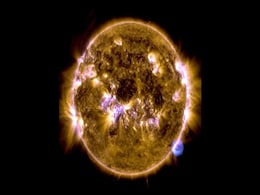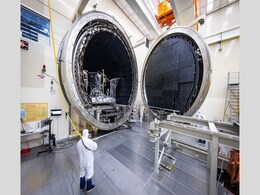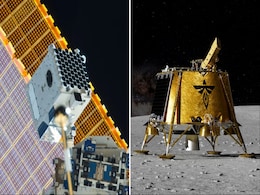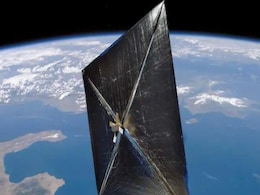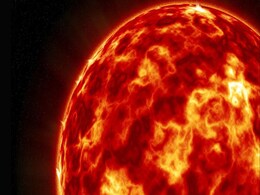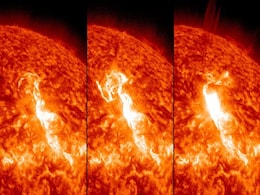Enhanced Weathering
- All
- News
-

Rock On: How Crushed Stone Could Help Fight Climate Change
- Tuesday June 24, 2025
- World News | Agence France-Presse
From sugar plantations in Brazil to tea estates in India, crushed rock is being sprinkled across large stretches of farmland globally in a novel bid to combat climate change. The technique is called Enhanced Rock Weathering (ERW).
-
 www.ndtv.com
www.ndtv.com
-

Parker Solar Probe Witnesses Unprecedented Sunward Plasma Jet Driven by Magnetic Reconnection
- Wednesday June 11, 2025
- Written by Gadgets 360 Staff
NASA's Parker Solar Probe has made a groundbreaking discovery, observing an unprecedented plasma explosion in the Sun's corona. This rare event produced a sunward jet of particles, with protons accelerated to nearly 1,000 times the expected energy. Scientists traced this phenomenon back to a magnetic reconnection site, where twisted solar magnetic ...
-
 www.gadgets360.com
www.gadgets360.com
-

Scientists Capture Plasma Streams, Coronal Raindrops in Sharpest-Ever View of Sun’s Corona
- Saturday May 31, 2025
- Written by Gadgets 360 Staff
For the first time, scientists have captured ultra-detailed footage of the sun’s outer atmosphere, showing coronal rain and a never-before-seen plasma stream. These new images were made possible by adaptive optics that cut through Earth’s atmospheric interference, revealing structures never observed before. The findings could unlock solar myste...
-
 www.gadgets360.com
www.gadgets360.com
-

NASA’s IMAP Spacecraft Prepares to Map the Solar System’s Edge
- Thursday May 15, 2025
- Written by Gadgets 360 Staff
NASA’s Interstellar Mapping and Acceleration Probe (IMAP) has been delivered to the Astrotech facility near Kennedy Space Center for final preparations ahead of a tentatively planned launch in fall 2025. IMAP will map the heliosphere — the solar wind-driven bubble that shields our solar system from cosmic radiation. It is to orbit near Lagrange...
-
 www.gadgets360.com
www.gadgets360.com
-

NASA’s EZIE Satellites Begin Mission to Study Auroral Electrojets and Space Weather
- Friday March 21, 2025
- Written by Gadgets 360 Staff
NASA’s Electrojet Zeeman Imaging Explorer (EZIE) mission has been launched aboard a SpaceX Falcon 9 from Vandenberg Space Force Base. The trio of small satellites will map auroral electrojets, powerful currents in Earth’s atmosphere linked to solar storms. Their data will enhance space weather prediction models and help understand planetary mag...
-
 www.gadgets360.com
www.gadgets360.com
-

NASA’s Space Station Research Aids Lunar Missions With Key Technologies
- Tuesday March 18, 2025
- Written by Gadgets 360 Staff
Research aboard the International Space Station is advancing lunar exploration. Firefly Aerospace’s Blue Ghost Mission-1, which landed on 2 March 2025, carries three experiments linked to space station studies. LEXI observes X-ray emissions to study space weather, RadPC tests radiation-tolerant computing, and LuGRE detects GNSS signals for lunar ...
-
 www.gadgets360.com
www.gadgets360.com
-

Aditya-L1’s SUIT Telescope Captures First-Ever Solar Flare Kernel, Revealing Unseen Solar Activity
- Friday March 7, 2025
- Written by Gadgets 360 Staff
India’s Aditya-L1 mission has achieved a historic milestone with its Solar Ultra-violet Imaging Telescope (SUIT) capturing the first-ever solar flare kernel in the near-ultraviolet spectrum. This unprecedented observation confirms energy transfer across different layers of the Sun's atmosphere, advancing the understanding of solar flares and spac...
-
 www.gadgets360.com
www.gadgets360.com
-

Solar Sail Satellites Could Enhance Space Weather Forecasting and Alerts
- Tuesday February 18, 2025
- Written by Gadgets 360 Staff
Solar sail satellites, harnessing sunlight for propulsion, are being developed to improve space weather forecasting. NOAA and NASA’s Solar Cruiser project aims to extend geomagnetic storm alert times by 50%, reducing risks to power grids, GPS, and air traffic. The new spacecraft, expected to launch in 2029, will move beyond traditional observatio...
-
 www.gadgets360.com
www.gadgets360.com
-

NASA’s PUNCH Mission Set to Track the Sun’s Corona and Solar Wind in 3D
- Friday February 7, 2025
- Written by Gadgets 360 Staff
NASA’s PUNCH mission, set for launch on Feb 27, will deploy four satellites to study the transition between the sun’s corona and the solar wind. The mission aims to improve understanding of space weather by capturing 3D images, helping predict solar storms with greater accuracy. The data will also complement NASA’s Parker Solar Probe, offerin...
-
 www.gadgets360.com
www.gadgets360.com
-

Massive Coronal Hole on Sun Sends High-Speed Solar Wind Toward Earth
- Tuesday February 4, 2025
- Written by Gadgets 360 Staff
A giant 800,000 km coronal hole on the Sun is unleashing high-speed solar wind toward Earth, potentially triggering a G1 geomagnetic storm on January 31 and February 1. The NOAA has issued a watch, predicting enhanced auroras in higher latitudes. While G1 storms are minor, they can impact satellites and power grids. The storm’s intensity remains ...
-
 www.gadgets360.com
www.gadgets360.com
-

Massive 500,000-Mile Coronal Hole on the Sun Blasts Solar Wind Toward Earth
- Thursday January 30, 2025
- Written by Gadgets 360 Staff
A gigantic coronal hole, spanning 500,000 miles, has formed on the sun’s surface, allowing solar wind to escape at speeds of over 310 miles per second. Forecasts indicate that this solar wind may reach Earth by January 31, triggering a minor (G1) geomagnetic storm. While no severe impact is expected, the storm could enhance auroras at higher lati...
-
 www.gadgets360.com
www.gadgets360.com
-

China’s Ceres-1 Rocket Successfully Deploys 5 Satellites for Weather and Remote Sensing
- Friday January 24, 2025
- Written by Gadgets 360 Staff
China's space industry continues to grow with the successful deployment of five satellites by the Ceres-1 rocket on 20 January. The payload included four Yunyao-1 meteorological satellites and the Jitianxing A-05 remote sensing satellite. This launch, conducted by Galactic Energy, marks a key milestone in China’s expanding commercial space sector...
-
 www.gadgets360.com
www.gadgets360.com
-

NASA Rockets Set to Journey Through Flickering, Disappearing Auroras
- Thursday January 23, 2025
- Written by Gadgets 360 Staff
NASA is set to launch two groundbreaking rocket missions in January 2025 to unravel the mysteries of auroras. The GIRAFF mission will study fast-pulsating and flickering auroras, while the Black and Diffuse Aurora Science Surveyor mission will focus on dark auroral patches or "black auroras." By using advanced instruments to measure electron activi...
-
 www.gadgets360.com
www.gadgets360.com
-

AI Enhances Northern Lights Classification and Geomagnetic Storm Forecasting
- Friday January 10, 2025
- Written by Gadgets 360 Staff
A breakthrough in auroral research, powered by artificial intelligence, has allowed scientists to classify over 700 million auroral images. This effort, using NASA's THEMIS dataset, will significantly enhance the prediction of geomagnetic storms, which can disrupt Earth's communication and security systems. Led by the University of New Hampshire, t...
-
 www.gadgets360.com
www.gadgets360.com
-

Cosmic Rays Could Help Scientists Study Tornado Formation Through Muon Detection
- Monday January 13, 2025
- Written by Gadgets 360 Staff
Cosmic rays and their byproduct, muons, may help scientists study tornado formation by detecting pressure changes remotely. This technique would avoid the need for direct measurements within dangerous storms. Researchers plan to use muon detectors over large areas or portable versions to track severe weather patterns. The findings could enhance und...
-
 www.gadgets360.com
www.gadgets360.com
-

Rock On: How Crushed Stone Could Help Fight Climate Change
- Tuesday June 24, 2025
- World News | Agence France-Presse
From sugar plantations in Brazil to tea estates in India, crushed rock is being sprinkled across large stretches of farmland globally in a novel bid to combat climate change. The technique is called Enhanced Rock Weathering (ERW).
-
 www.ndtv.com
www.ndtv.com
-

Parker Solar Probe Witnesses Unprecedented Sunward Plasma Jet Driven by Magnetic Reconnection
- Wednesday June 11, 2025
- Written by Gadgets 360 Staff
NASA's Parker Solar Probe has made a groundbreaking discovery, observing an unprecedented plasma explosion in the Sun's corona. This rare event produced a sunward jet of particles, with protons accelerated to nearly 1,000 times the expected energy. Scientists traced this phenomenon back to a magnetic reconnection site, where twisted solar magnetic ...
-
 www.gadgets360.com
www.gadgets360.com
-

Scientists Capture Plasma Streams, Coronal Raindrops in Sharpest-Ever View of Sun’s Corona
- Saturday May 31, 2025
- Written by Gadgets 360 Staff
For the first time, scientists have captured ultra-detailed footage of the sun’s outer atmosphere, showing coronal rain and a never-before-seen plasma stream. These new images were made possible by adaptive optics that cut through Earth’s atmospheric interference, revealing structures never observed before. The findings could unlock solar myste...
-
 www.gadgets360.com
www.gadgets360.com
-

NASA’s IMAP Spacecraft Prepares to Map the Solar System’s Edge
- Thursday May 15, 2025
- Written by Gadgets 360 Staff
NASA’s Interstellar Mapping and Acceleration Probe (IMAP) has been delivered to the Astrotech facility near Kennedy Space Center for final preparations ahead of a tentatively planned launch in fall 2025. IMAP will map the heliosphere — the solar wind-driven bubble that shields our solar system from cosmic radiation. It is to orbit near Lagrange...
-
 www.gadgets360.com
www.gadgets360.com
-

NASA’s EZIE Satellites Begin Mission to Study Auroral Electrojets and Space Weather
- Friday March 21, 2025
- Written by Gadgets 360 Staff
NASA’s Electrojet Zeeman Imaging Explorer (EZIE) mission has been launched aboard a SpaceX Falcon 9 from Vandenberg Space Force Base. The trio of small satellites will map auroral electrojets, powerful currents in Earth’s atmosphere linked to solar storms. Their data will enhance space weather prediction models and help understand planetary mag...
-
 www.gadgets360.com
www.gadgets360.com
-

NASA’s Space Station Research Aids Lunar Missions With Key Technologies
- Tuesday March 18, 2025
- Written by Gadgets 360 Staff
Research aboard the International Space Station is advancing lunar exploration. Firefly Aerospace’s Blue Ghost Mission-1, which landed on 2 March 2025, carries three experiments linked to space station studies. LEXI observes X-ray emissions to study space weather, RadPC tests radiation-tolerant computing, and LuGRE detects GNSS signals for lunar ...
-
 www.gadgets360.com
www.gadgets360.com
-

Aditya-L1’s SUIT Telescope Captures First-Ever Solar Flare Kernel, Revealing Unseen Solar Activity
- Friday March 7, 2025
- Written by Gadgets 360 Staff
India’s Aditya-L1 mission has achieved a historic milestone with its Solar Ultra-violet Imaging Telescope (SUIT) capturing the first-ever solar flare kernel in the near-ultraviolet spectrum. This unprecedented observation confirms energy transfer across different layers of the Sun's atmosphere, advancing the understanding of solar flares and spac...
-
 www.gadgets360.com
www.gadgets360.com
-

Solar Sail Satellites Could Enhance Space Weather Forecasting and Alerts
- Tuesday February 18, 2025
- Written by Gadgets 360 Staff
Solar sail satellites, harnessing sunlight for propulsion, are being developed to improve space weather forecasting. NOAA and NASA’s Solar Cruiser project aims to extend geomagnetic storm alert times by 50%, reducing risks to power grids, GPS, and air traffic. The new spacecraft, expected to launch in 2029, will move beyond traditional observatio...
-
 www.gadgets360.com
www.gadgets360.com
-

NASA’s PUNCH Mission Set to Track the Sun’s Corona and Solar Wind in 3D
- Friday February 7, 2025
- Written by Gadgets 360 Staff
NASA’s PUNCH mission, set for launch on Feb 27, will deploy four satellites to study the transition between the sun’s corona and the solar wind. The mission aims to improve understanding of space weather by capturing 3D images, helping predict solar storms with greater accuracy. The data will also complement NASA’s Parker Solar Probe, offerin...
-
 www.gadgets360.com
www.gadgets360.com
-

Massive Coronal Hole on Sun Sends High-Speed Solar Wind Toward Earth
- Tuesday February 4, 2025
- Written by Gadgets 360 Staff
A giant 800,000 km coronal hole on the Sun is unleashing high-speed solar wind toward Earth, potentially triggering a G1 geomagnetic storm on January 31 and February 1. The NOAA has issued a watch, predicting enhanced auroras in higher latitudes. While G1 storms are minor, they can impact satellites and power grids. The storm’s intensity remains ...
-
 www.gadgets360.com
www.gadgets360.com
-

Massive 500,000-Mile Coronal Hole on the Sun Blasts Solar Wind Toward Earth
- Thursday January 30, 2025
- Written by Gadgets 360 Staff
A gigantic coronal hole, spanning 500,000 miles, has formed on the sun’s surface, allowing solar wind to escape at speeds of over 310 miles per second. Forecasts indicate that this solar wind may reach Earth by January 31, triggering a minor (G1) geomagnetic storm. While no severe impact is expected, the storm could enhance auroras at higher lati...
-
 www.gadgets360.com
www.gadgets360.com
-

China’s Ceres-1 Rocket Successfully Deploys 5 Satellites for Weather and Remote Sensing
- Friday January 24, 2025
- Written by Gadgets 360 Staff
China's space industry continues to grow with the successful deployment of five satellites by the Ceres-1 rocket on 20 January. The payload included four Yunyao-1 meteorological satellites and the Jitianxing A-05 remote sensing satellite. This launch, conducted by Galactic Energy, marks a key milestone in China’s expanding commercial space sector...
-
 www.gadgets360.com
www.gadgets360.com
-

NASA Rockets Set to Journey Through Flickering, Disappearing Auroras
- Thursday January 23, 2025
- Written by Gadgets 360 Staff
NASA is set to launch two groundbreaking rocket missions in January 2025 to unravel the mysteries of auroras. The GIRAFF mission will study fast-pulsating and flickering auroras, while the Black and Diffuse Aurora Science Surveyor mission will focus on dark auroral patches or "black auroras." By using advanced instruments to measure electron activi...
-
 www.gadgets360.com
www.gadgets360.com
-

AI Enhances Northern Lights Classification and Geomagnetic Storm Forecasting
- Friday January 10, 2025
- Written by Gadgets 360 Staff
A breakthrough in auroral research, powered by artificial intelligence, has allowed scientists to classify over 700 million auroral images. This effort, using NASA's THEMIS dataset, will significantly enhance the prediction of geomagnetic storms, which can disrupt Earth's communication and security systems. Led by the University of New Hampshire, t...
-
 www.gadgets360.com
www.gadgets360.com
-

Cosmic Rays Could Help Scientists Study Tornado Formation Through Muon Detection
- Monday January 13, 2025
- Written by Gadgets 360 Staff
Cosmic rays and their byproduct, muons, may help scientists study tornado formation by detecting pressure changes remotely. This technique would avoid the need for direct measurements within dangerous storms. Researchers plan to use muon detectors over large areas or portable versions to track severe weather patterns. The findings could enhance und...
-
 www.gadgets360.com
www.gadgets360.com


